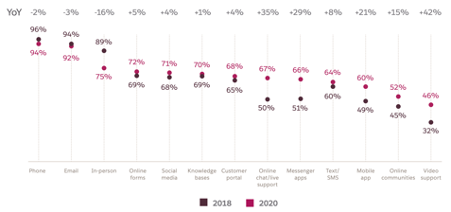Since February or March of Anno Domini 2020, the Corona pandemic is making the headlines and is driving digital transformation, or at least the digitalization of businesses.
For sure, this crisis has forced and is continuing to force many a company into enabling its employees to work remotely. This has accelerated an already ongoing fundamental change of the way people work.
It has also had an impact on work culture.
People can no more just drop by a colleague to ask a question, but need to pick up a phone. Meetings do not happen in the meeting room around the corner anymore but by utilizing technology – virtual meeting rooms – voice and video. Salespeople can no more travel to their customers for face-to-face meetings. Instead they were forced to adopt and master virtual meetings, something they didn’t believe they could possibly do in 2019. It seemed far too alien.
Many of us have learned that this change is rather an opportunity than a threat. We needed to, and did adapt, on a business- and a personal level. In doing so, we realized that many things that we thought of “will never work” actually work quite well.
This adaption happened and happens in three distinct steps. We first used any available technology, just to keep the lights on. Then we started to put processes around them to become more effective and now we are looking at improving efficiencies. These efficiencies, that we look for, will be achieved by the harmonization and reduction of the number of the used tools and their deep integration into each other and essential business systems.
And make no error, the change we have done will stick to quite an extent as a recent Stanford study, that surveyed 15,000 Americans, found. The survey evidence suggests, that more than twenty percent of all full work days will be supplied from home or distributed offices even after the pandemic ends.
This jibes with results of the fourth editions of the Salesforce State of Service and State of the Connected Customer surveys. According to the State of the Connected Customer report, the phone is customers’ second-most preferred communication channel (up from place three in 2019). According to the State of Service report, It is also the communication channel that is most widely supported by service organizations.
In addition, the report finds that “agents also prefer the phone for complex issues that require two-way conversation, and don’t see the phone being replaced any time soon. However, how agents answer and process phone calls is evolving. The majority of service agents – aside from those on underperforming teams – are more likely to handle voice calls through a computer than a desk phone.”

Figure 1: Service Organizations that report using the following channels; source Salesforce State of Service 4th edition
What is also notable is the strong growth of online chat, messenger apps, and video support between 2018 and 2020.
By extension, the same preferences apply to colleagues cooperating on any given topic. They, too, need and want to communicate using phone, chat, or video.
In addition, they want to use this without hassle, anytime, from everywhere, and with any device.
So, there is certainly a necessity for businesses to enable their workforce for efficient digital communication. This can be done using standalone specialized tools, integrated and embedded tools, up to and until full communications suites like Slack or Microsoft Teams, which are mainly run standalone and in parallel to business systems.
From an efficiency and user experience point of view, integration is key. Employees need to be able to stay within the frame of the business applications they use rather than switching between applications and changing contexts. The communication tool needs to share data and information that is created directly with the business applications it is integrated into. Only then is the tool of maximum help for the people and hence gets best acceptance.
From an IT point of view, installation and configuration must be smooth and simple, done without a major project or cost, which means that they need to be built into the business application, rather than attached to it.
This is where vendors like e.g. Ringcentral, Aircall or Fastcall come into the picture. Searching for CTI on Salesforce AppExchange reveals many options. These vendors offer the tools that extend Salesforce to enable CTI. The differences between the former two and Fastcall are that Fastcall is specialized on, built exclusively for one vendor – Salesforce – and made part of the Salesforce code stack, whereas the others are not. Hence Fastcall is best suited to fulfil the needs of Salesforce users, including a seamless UX.
And for the geeks amongst us: without API calls, which reduces the complexity of the IT landscape and therefore increases the RoI.
Summarizing, if business leaders are looking out for a strong, integrated toolset for internal as well as external communication to gain the efficiencies they want, they need to look out for the following traits offered by the software:
- First and foremost: The software needs to do the job of making life for the employees easier
- It needs to be embedded into the host software, and not run side by side
- Ideally, the vendor is specialized on the software stack that your employees use and the software uses the same UI as the host software
- The software needs to share information and data with the host software and write into the same database
- The vendor needs to offer good support and regular, frequent updates to the software
That’s it. This catalogue will point you into the right direction for finding a well-integrated solution for your CTI needs.

